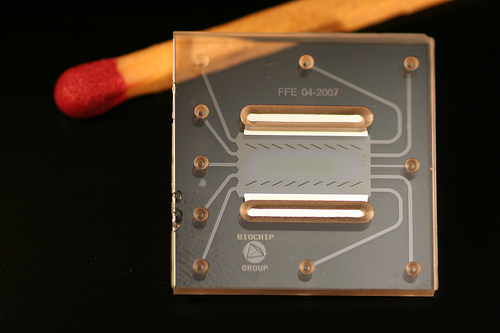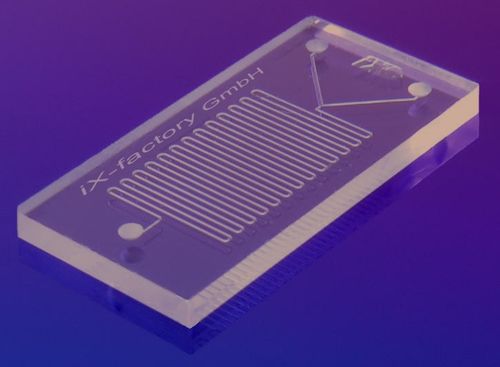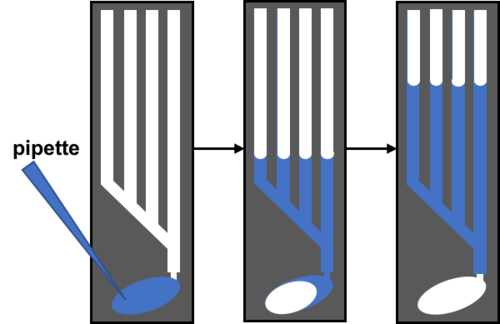Microfluidics
Main > Food and Agriculture > Pests and weeds
Microfluidics refers to a set of technologies that control the flow of minute amounts of liquids or gases — typically measured in nano- and picoliters — in a miniaturized system.
Just as a computer chip has carefully-arranged wires that electricity moves around, a microfluidic chip has tiny channels etched onto it that fluids move around. In a biochemistry laboratory, a chemist might pipette some solution out of a flask, mix it with a reagent, fractionate it, or perform other operations on it. The interesting thing is that most of these processes are just a matter of moving liquids around, so they can be replicated with microfluidics. The advantage is that microfluidics is much cheaper, safer and requires less skill. Room-sized diagnostic testing equipment can be shrunk down to the size of a postage stamp. This is also called "lab-on-a-chip".
Applications are as vast as they are revolutionary, and include -
- Medical diagnostics and blood tests
- Medical and chemical research - testing for genes, chemical separation and reactions
- Environmental sensing - testing water quality, air quality, monitoring for environmental toxins
- Testing for plant diseases
- Testing soils (biosensor example here)
- mining
- developing biofuels
- and many more.
Microfluidics in Open Source Ecology
We are interested in very cheap, open-source ways of making microfluidic chips. There are plenty of groups working on this; it's a matter of gathering the information.
DIY microfluidics methods
- How to make a microfluidic chip using double-sided sellotape, glass slides and a scalpel: [1]. This requires inlet and outlet holes in the slide; perhaps these could be made with a laser cutter?
- Complex 3D microfluidic devices made with alternating layers of paper and double-sided tape: [2]. The tape was cut using a laser cutter. The paper was treated with photoresist (a light-sensitive polymer) and exposed to UV light when masked with a transparency with a pattern printed onto it. Cost of fabricating a chip = $0.03.
- Disposable microfluidic devices created using regular wax paper
- Shrinky Dink® microfluidics - academic paper here
Channel designs
Are there online repositories of channel designs for different purposes?
Micado is open-source software for designing microfluidic chips.
Materials and Equipment Used
Consumables:
- blotter paper
- regular paper
- wax paper, shrinky-dink
- transparency film
- cotton thread
- sewing needles
- wood sticks
- Jell-O
- beeswax?
Equipment:
- syringes
- cell phone cameras
- plastic lenses for cheap microscopes
- Laser cutter, see Low-cost rapid prototyping of flexible microfluidic devices using a desktop digital craft cutter
George Whitesides, Harvard University
In his legendary career in chemistry, George Whitesides has been a pioneer in microfabrication and nanoscale self-assembly. Now, he's fabbing a diagnostic lab on a chip.
OpenDiagnostics
OpenDiagnostics are working to develop and promote a new type of open source, paper-based diagnostic. Proof-of-concept for similar tests has already been demonstrated for detecting Zika and Ebola viruses. Since they are low cost, thermally stable, and easy to use, these strips are well suited to bring diagnostic capabilities to the Global South – across areas spanning healthcare, agriculture and environmental monitoring.
Harnessing recent advances in synthetic biology and paper microfluidics, cell-free paper-based diagnostics offer a platform for low cost, in-field tests with a very wide range of possible specificities. Synthetic gene networks can be designed to generate quantifiable outputs, such as chromoproteins, in the presence of specific input signals like heavy metals or viral RNA sequences. These are freeze-dried onto paper, along with the cellular machinery used for gene transcription and translation. When rehydrated, rapid determination of the presence/absence of a substance of interest can be made. With a simple visible readout, little or no laboratory experience or infrastructure is required.
Metafluidics
Abstract from 2017 paper in Nature Biotech (open access): "Open-source, community-driven microfluidics with Metafluidics"
Microfluidic devices have the potential to automate and miniaturize biological experiments, but open-source sharing of device designs has lagged behind sharing of other resources such as software. Synthetic biologists have used microfluidics for DNA assembly, cell-free expression, and cell culture, but a combination of expense, device complexity, and reliance on custom set-ups hampers their widespread adoption. We present Metafluidics, an open-source, community-driven repository that hosts digital design files, assembly specifications, and open-source software to enable users to build, configure, and operate a microfluidic device. We use Metafluidics to share designs and fabrication instructions for both a microfluidic ring-mixer device and a 32-channel tabletop microfluidic controller. This device and controller are applied to build genetic circuits using standard DNA assembly methods including ligation, Gateway, Gibson, and Golden Gate. Metafluidics is intended to enable a broad community of engineers, DIY enthusiasts, and other nontraditional participants with limited fabrication skills to contribute to microfluidic research.
Further Reading
- Wikipedia: Microfluidics and Lab-on-a-chip
- DIY Bio
- Diagnostics For All
- Daktari


